Mechanical Performance of Methane Hydrate–Coal Mixture
Abstract
:1. Introduction
2. Test Program
2.1. Apparatus
2.2. Specimen Preparation
2.3. Formation of Methane Hydrates in Coal Samples and Experimental Procedure
3. Results
3.1. Triaxial Compression Test
3.2. Correlations between Peak Strength and Saturation, and between Peak Strength and Confining Pressure
3.3. Correlation of Residual Strength with Hydrate Saturation and Confining Pressure
3.4. Correlations of Peak Strain with Hydrate Saturation and Confining Pressure
3.5. Correlations of Elastic Modulus with Hydrate Saturation and Confining Pressure
4. Discussion
5. Conclusions
Author Contributions
Acknowledgments
Conflicts of Interest
References
- Li, Z.H.; Wang, E.Y.; Ou, J.C.; Liu, Z.T. Hazard Evaluation of Coal and Gas Outbursts in a Coal-Mine Roadway based on Logistic Regression Model. Int. J. Rock Mech. Min. 2015, 80, 185–195. [Google Scholar] [CrossRef]
- Beamish, B.B.; Crosdale, P.J. Instantaneous Outbursts in Underground Coal Mines: An Overview and Association with Coal Type. Int. J. Coal Geol. 1998, 35, 27–55. [Google Scholar] [CrossRef]
- Fisne, A.; Esen, O. Coal and Gas Outburst Hazard in Zonguldak Coal Basin of Turkey, and Association with Geological Parameters. Nat. Hazards 2014, 74, 1363–1390. [Google Scholar] [CrossRef]
- Wang, S.G.; Elsworth, D.; Liu, J.S. Mechanical Behavior of Methane Infiltrated Coal: The Roles of Gas Desorption, Stress Level and Loading Rate. Rock Mech. Rock Eng. 2013, 46, 945–958. [Google Scholar] [CrossRef]
- Xu, L.H.; Jiang, C.L. Initial Desorption Characterization of Methane and Carbon Dioxide in Coal and its Influence on Coal and Gas Outburst Risk. Fuel 2017, 203, 700–706. [Google Scholar] [CrossRef]
- Lu, T.K.; Zhao, Z.J.; Hu, H.F. Improving the Gate Road Development Rate and Reducing Outburst Occurrences using the Water Jet Technique in High Gas Content Outburst-Prone Soft Coal Seam. Int. J. Rock Mech. Min. 2011, 48, 1271–1282. [Google Scholar] [CrossRef]
- Lama, R.D.; Bodziony, J. Management of Outburst in Underground Coal Mines. Int. J. Coal Geol. 1998, 35, 83–115. [Google Scholar] [CrossRef]
- Karacan, C.Ö.; Ruiz, F.A.; Cotè, M.; Phipps, S. Coal Mine Methane: A Review of Capture and Utilization Practices with Benefits to Mining Safety and to Greenhouse Gas Reduction. Int. J. Coal Geol. 2011, 86, 121–156. [Google Scholar] [CrossRef]
- Zhou, P.L.; Zhang, Y.H.; Huang, Z.A.; Gao, Y.K.; Wang, H.; Luo, Q. Coal and Gas Outburst Prevention using New High Water Content Cement Slurry for Injection into the Coal Seam. Int. J. Min. Sci. Technol. 2017, 27, 669–673. [Google Scholar] [CrossRef]
- Wu, Q.; Li, C.L.; Jing, C.L. Discussion on the Control Factors of Gas Hydrate Formation. J. China Coal Soc. 2005, 30, 283–287. (In Chinese) [Google Scholar]
- Gao, X.; Gao, C.; Zhang, B.Y.; Wu, Q.; Liu, W.X.; Wang, L.N. Experimental Investigation on Mechanical Behavior of Methane Hydrate Bearing Coal under Triaxial Compression. Electron. J. Geotech. Eng. 2015, 20, 94–112. [Google Scholar]
- Hyodo, M.; Nakata, Y.; Yoshimoto, N.; Ebinuma, T. Basic Research on the Mechanical Behavior of Methane Hydrate-Sediments Mixture. Soils Found. 2005, 45, 75–85. [Google Scholar]
- Hyodo, M.; Ling, Y.H.; Yoneda, J.; Nakata, Y.; Yoshimoto, N.; Nishimura, A.; Song, Y.C. Mechanical behavior of Gas-saturated Methane Hydrate-bearing Sediments. J. Geophys. Res. Solid Earth 2013, 118, 5185–5194. [Google Scholar] [CrossRef]
- Masui, A.; Haneda, H.; Ogata, Y.; Aoki, K. Effects of Methane Hydrate Formation on Shear Strength of Synthetic Methane Hydrate Sediments. In Proceedings of the 15th International Offshore and Polar Engineering Conference, Seoul, Korea, 19–24 June 2005. [Google Scholar]
- Miyazaki, K.; Masui, A.; Yamaguchi, T.; Sakamoto, Y.; Haneda, H.; Ogata, Y.; Aoki, K.; Okubo, S. Strain Rate Dependency of Peak and Residual Strength of Sediment Containing Synthetic Methane Hydrate. J. MMIJ 2008, 124, 619–625. [Google Scholar] [CrossRef] [Green Version]
- Miyazaki, K.; Masui, A.; Sakamoto, Y.; Aoki, K.; Tenma, N.; Yamaguchi, K. Triaxial Compressive Properties of Artificial Methane-hydrate-bearing Sediment. J. Geophys. Res. 2011, 116, 1–11. [Google Scholar] [CrossRef]
- Clayton, C.R.I.; Priest, J.A.; Best, A.I. The Effects of Disseminated Methane Hydrate on the Dynamic Stiffness and Damping of a Sand. Geotechnique 2005, 55, 423–434. [Google Scholar] [CrossRef]
- Clayton, C.R.I.; Priest, J.A.; Rees, E.V.L. The Effects of Hydrate Cement on the Stiffness of Some Sands. Geotechnique 2010, 60, 435–445. [Google Scholar] [CrossRef]
- Yun, T.S.; Francisca, F.M.; Santamarina, J.C.; Ruppel, C. Compressional and Shear Wave Velocities in Uncemented Sediment Containing Gas Hydrate. Geophys. Res. Lett. 2005, 32, 1–5. [Google Scholar] [CrossRef]
- Yun, T.S.; Santamarina, C.J.; Ruppel, C. Mechanical Properties of Sand, Silt, and Clay Containing Tetrahydrofuran Hydrate. J. Geophys. Res. Solid Earth 2007, 112, 1–13. [Google Scholar] [CrossRef]
- Santamarina, J.C. The Impact of Hydrate Saturation on the Mechanical, Electrical, and Thermal Properties of Hydrate-Bearing Sand, Silts, and Clay. In Proceedings of the 6th International Conference on Gas Hydrates, Vancouver, BC, Canada, 6–10 July 2008. [Google Scholar]
- Song, Y.C.; Yu, F.; Li, Y.H.; Liu, W.G.; Zhao, J.F. Mechanical Property of Artificial Methane Hydrate under Triaxial Compression. J. Nat. Gas Chem. 2010, 19, 246–250. [Google Scholar] [CrossRef]
- Song, Y.C.; Zhu, Y.M.; Liu, W.G.; Li, Y.H.; Lu, Y.; Shen, Z.T. The Effects of Methane Hydrate Dissociation at Different Temperatures on the Stability of Porous Sediments. J. Pet. Sci. Eng. 2016, 147, 77–86. [Google Scholar] [CrossRef]
- Yu, F.; Song, Y.; Liu, W.; Li, Y.; Lam, W. Analyses of Stress Strain Behavior and Constitutive Model of Artificial Methane Hydrate. J. Pet. Sci. Eng. 2011, 77, 183–188. [Google Scholar] [CrossRef]
- Liu, W.G.; Zhao, J.F.; Luo, Y.; Song, Y.C.; Li, Y.H.; Yang, M.J.; Zhang, Y.; Liu, Y.; Wang, D.Y. Experimental Measurements of Mechanical Properties of Carbon Dioxide Hydrate-Bearing Sediments. Mar. Pet. Geol. 2013, 46, 201–209. [Google Scholar] [CrossRef]
- Liu, Z.C.; Wei, H.Z.; Peng, L.; Wei, C.F.; Ning, F.L. An Easy and Efficient Way to Evaluate Mechanical Properties of Gas Hydrate-Bearing Sediments: The direct Shear Test. J. Pet. Sci. Eng. 2017, 149, 56–64. [Google Scholar] [CrossRef]
- Hoodt, B.B. Coal and Gas Outburst; Song, S.Z., Wang, Y.A., Eds.; China Industry Press: Beijing, China, 1966. [Google Scholar]
- Zhou, Z.; Lu, Y.Y.; Ge, Z.L.; Yang, F.; Zhang, X.W. Coal and rock strength characteristics and experimental study under the coupling of water, gas and coal. J. China Coal Soc. 2014, 39, 2418–2424. (In Chinese) [Google Scholar]
- Waite, W.F.; Santamarina, J.C.; Cortes, D.D.; Dugan, B.; Espinoza, D.N.; Germaine, J.; Jang, J.; Jung, J.W.; Kneafsey, T.J.; Shin, H.; et al. Physical Properties of Hydrate-Bearing Sediments. Rev. Geophys. 2009, 47. [Google Scholar] [CrossRef]
- Yoneda, J.; Jin, Y.; Katagiri, J.; Tenma, N. Strengthening mechanism of cemented hydrate-bearing sand at microscales. Geophys. Res. Lett. 2016, 43, 7442–7450. [Google Scholar] [CrossRef]
- Priest, J.A.; Best, A.I.; Clayton, C.R.I. A laboratory investigation into the seismic velocities of methane gas hydrate-bearing sand. J. Geophys. Res. 2005, 110, 1–13. [Google Scholar] [CrossRef]
- Hyodo, M.; Yoneda, J.; Yoshimoto, N.; Nakata, Y. Mechanical and dissociation properties of methane hydrate-bearing sand in deep seabed. Soils Found. 2013, 53, 299–314. [Google Scholar] [CrossRef]

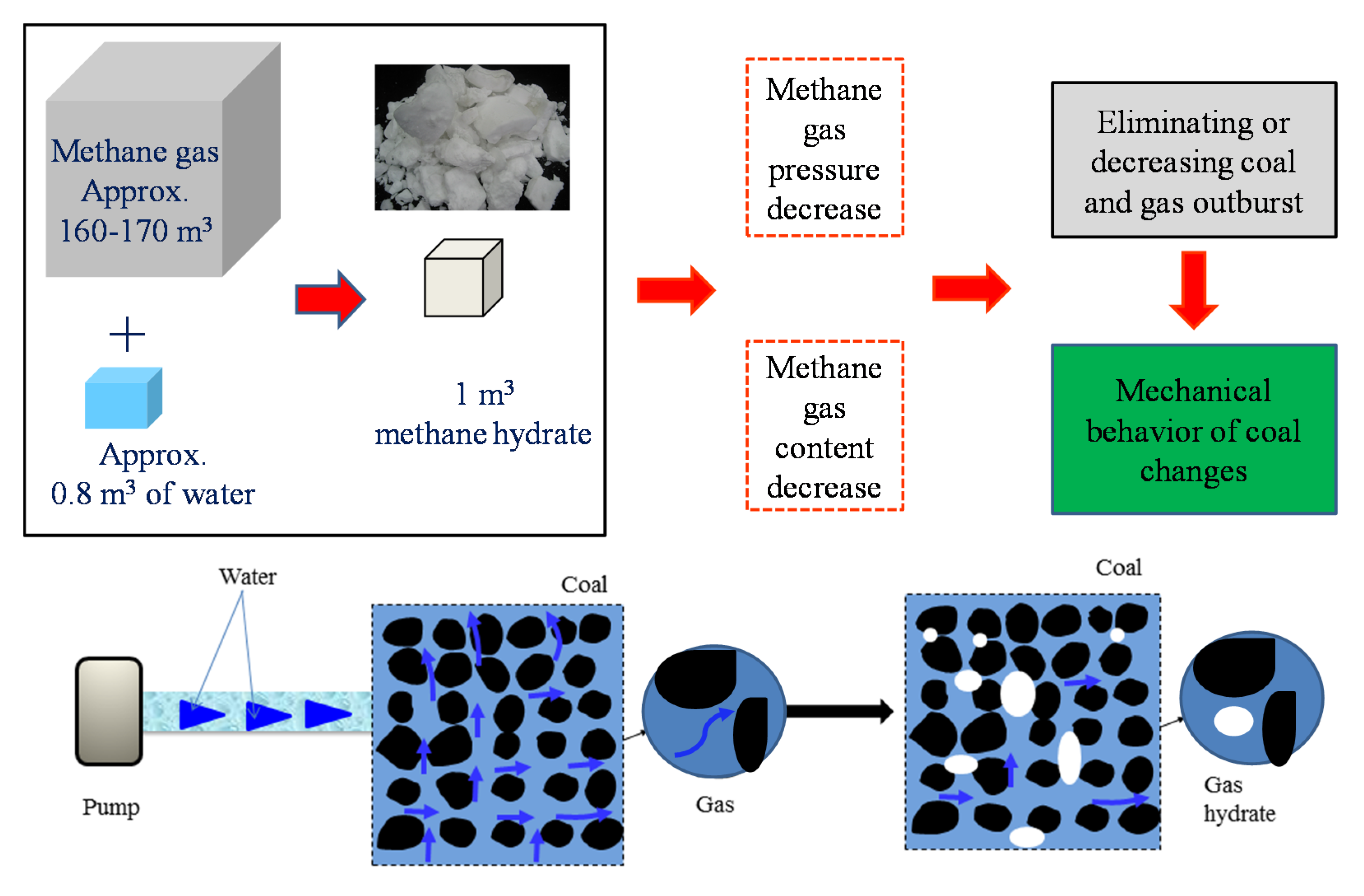

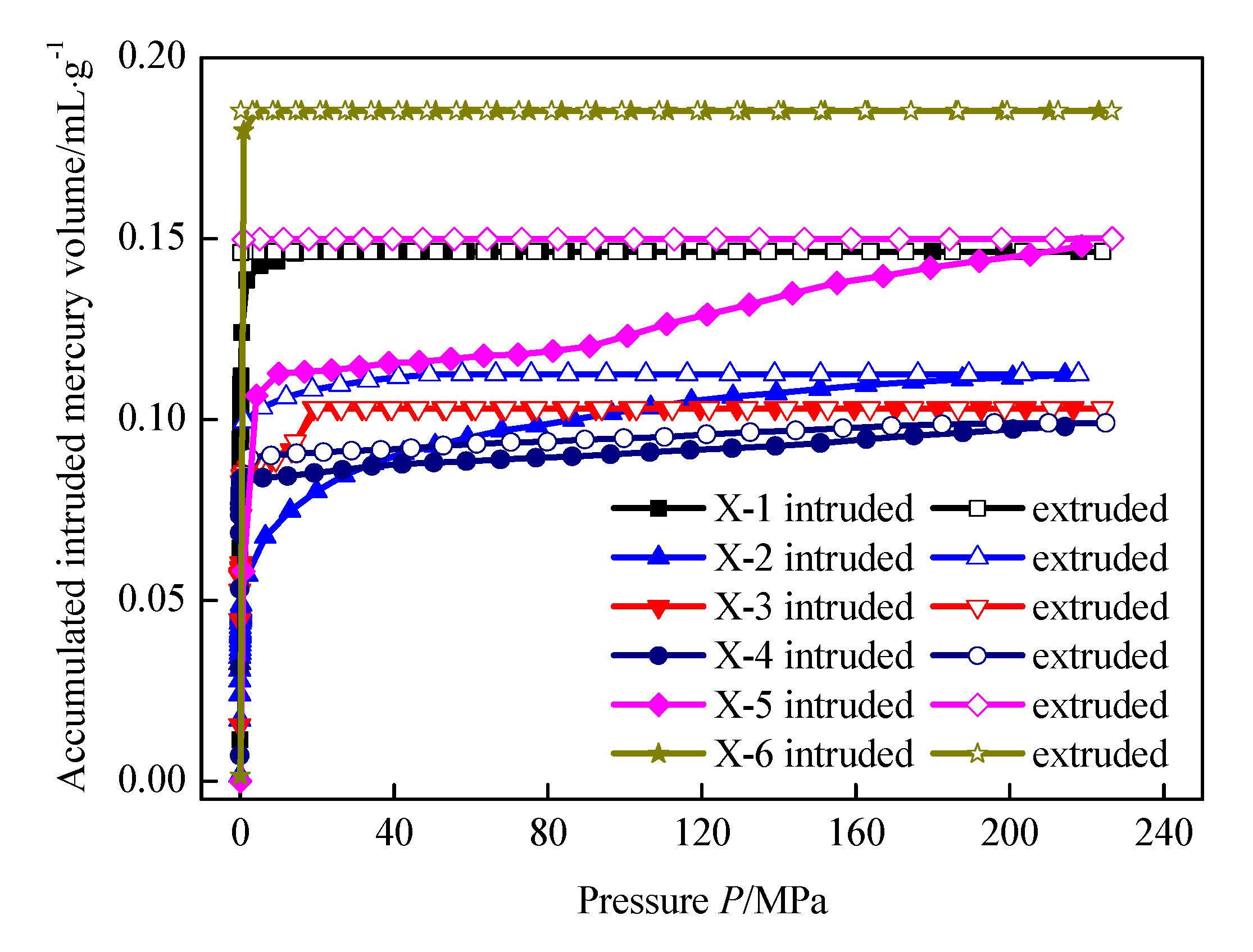
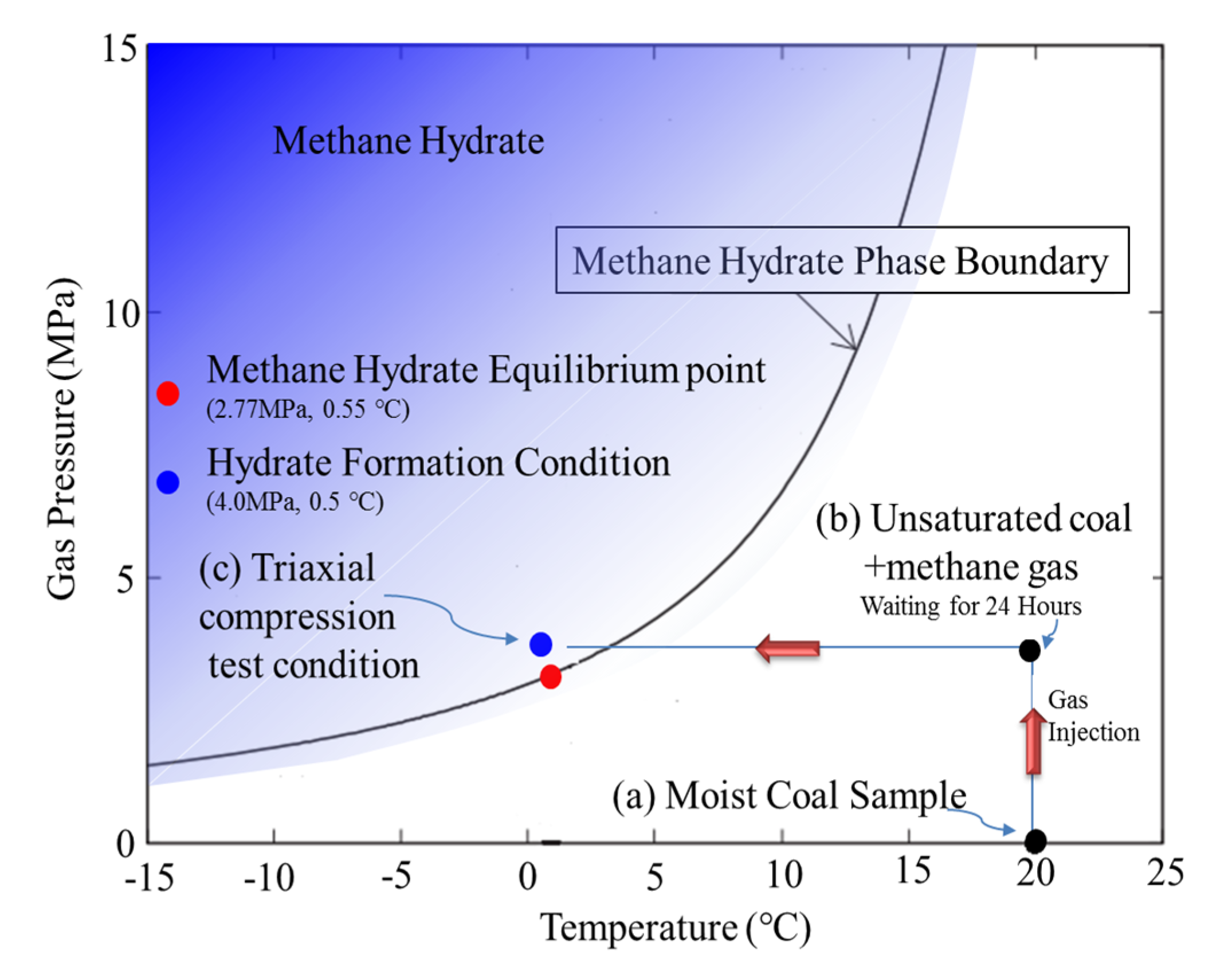
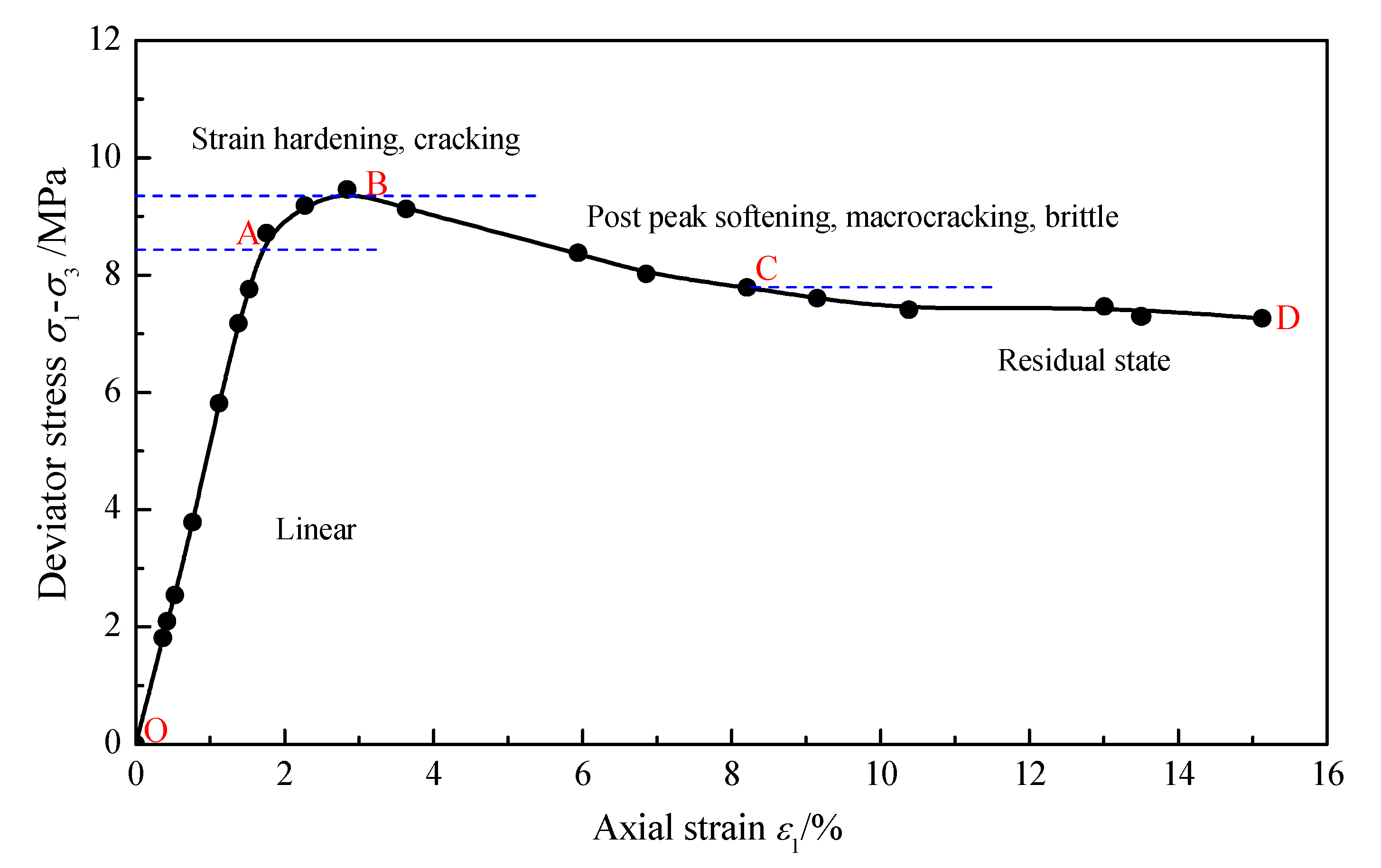
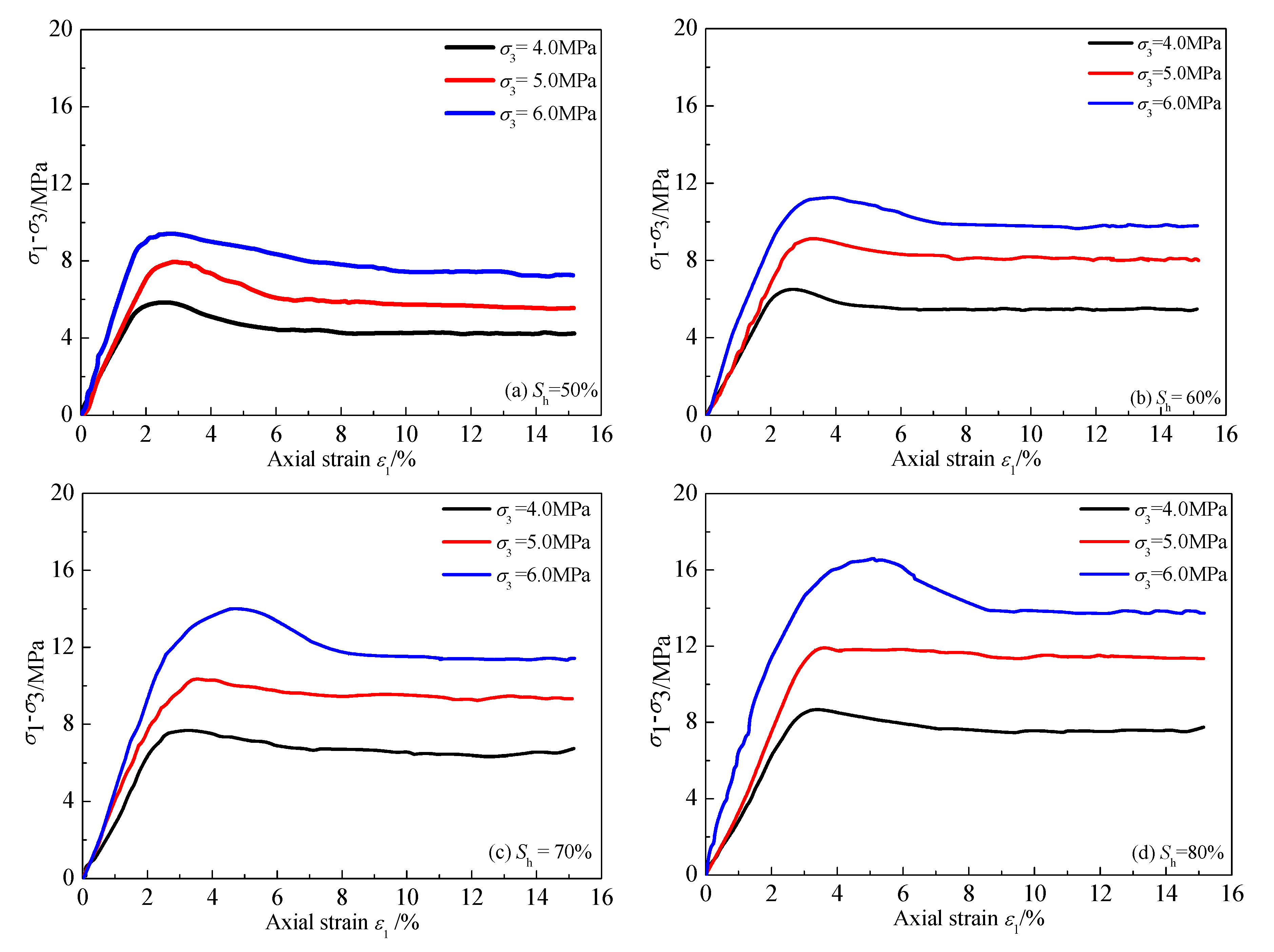
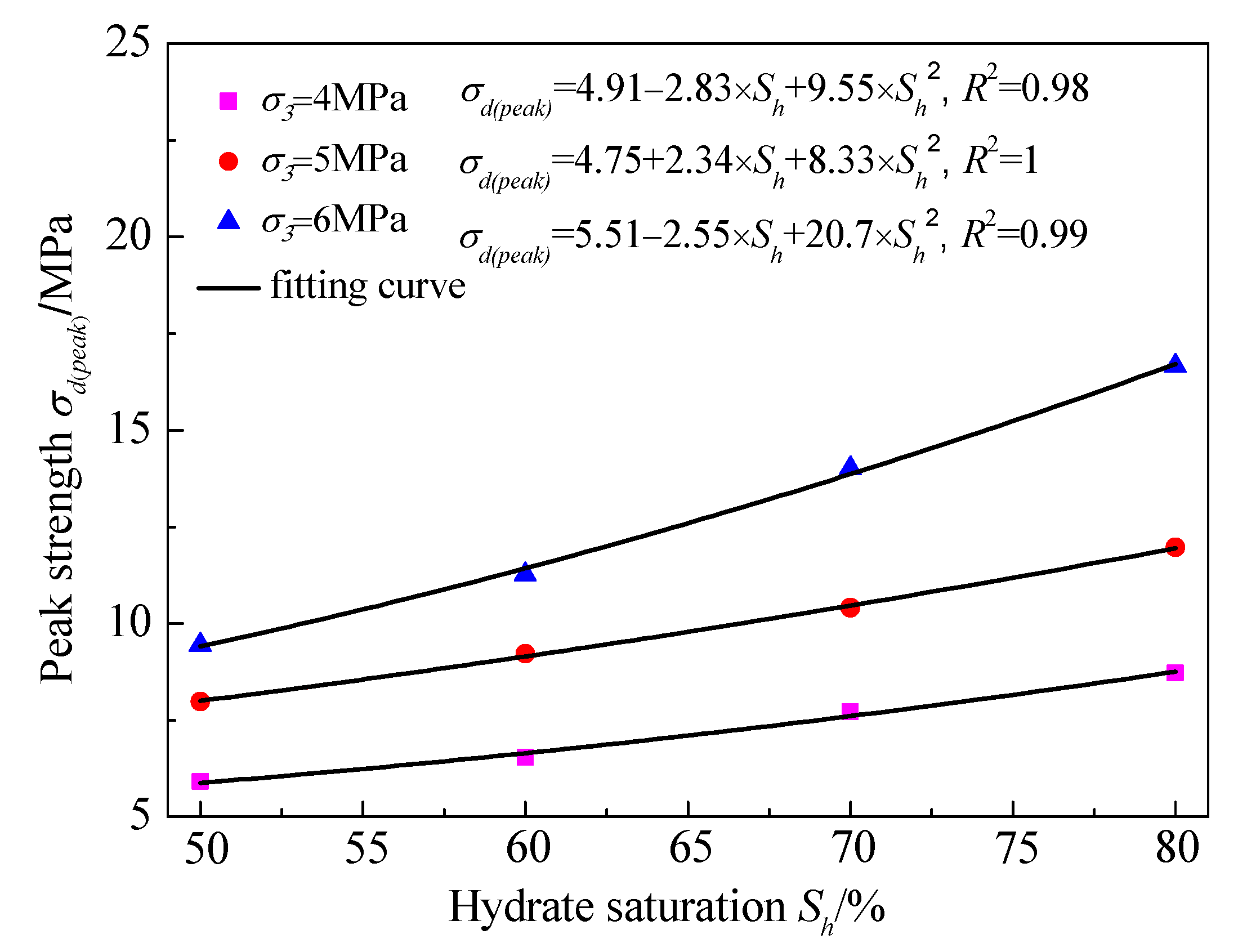
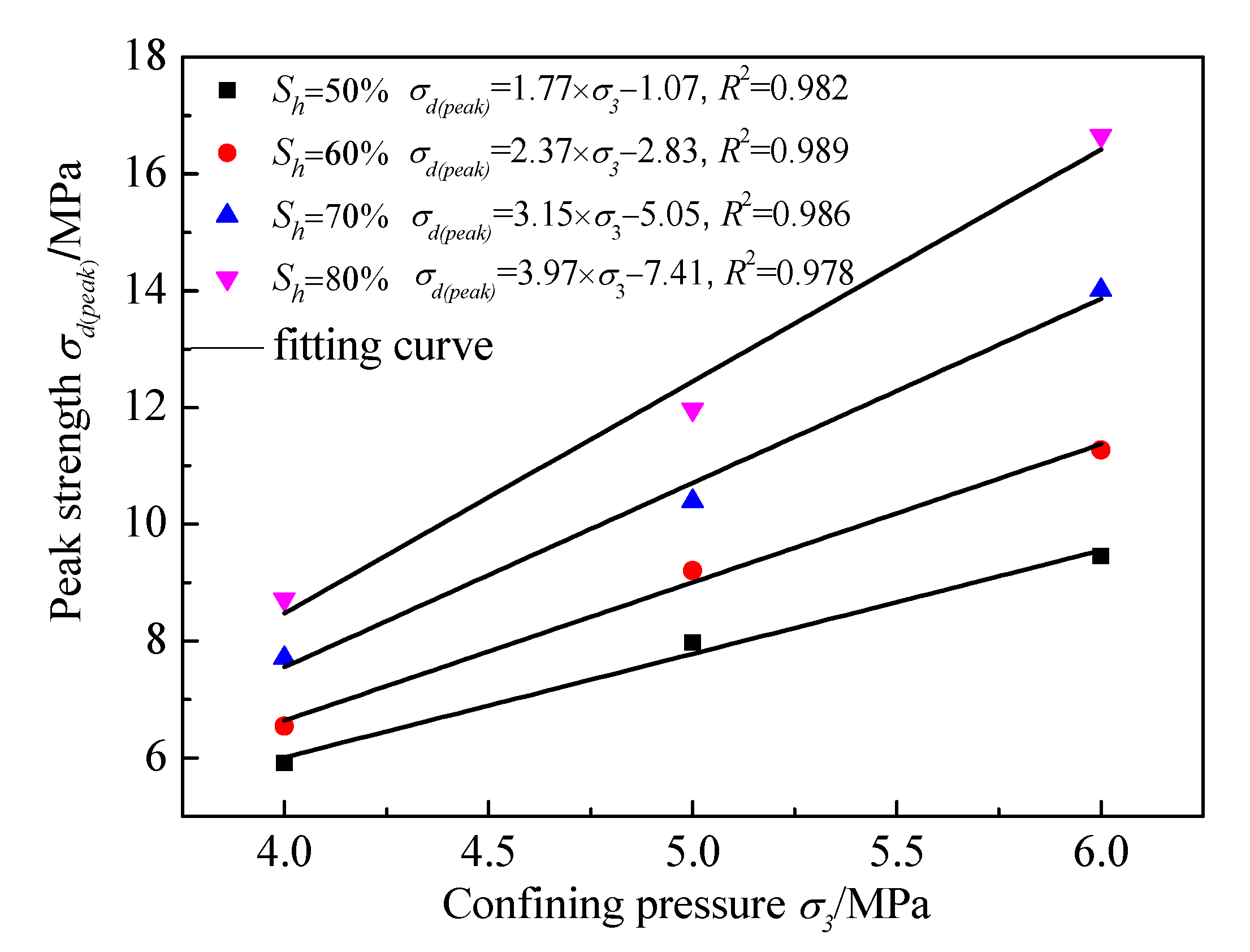
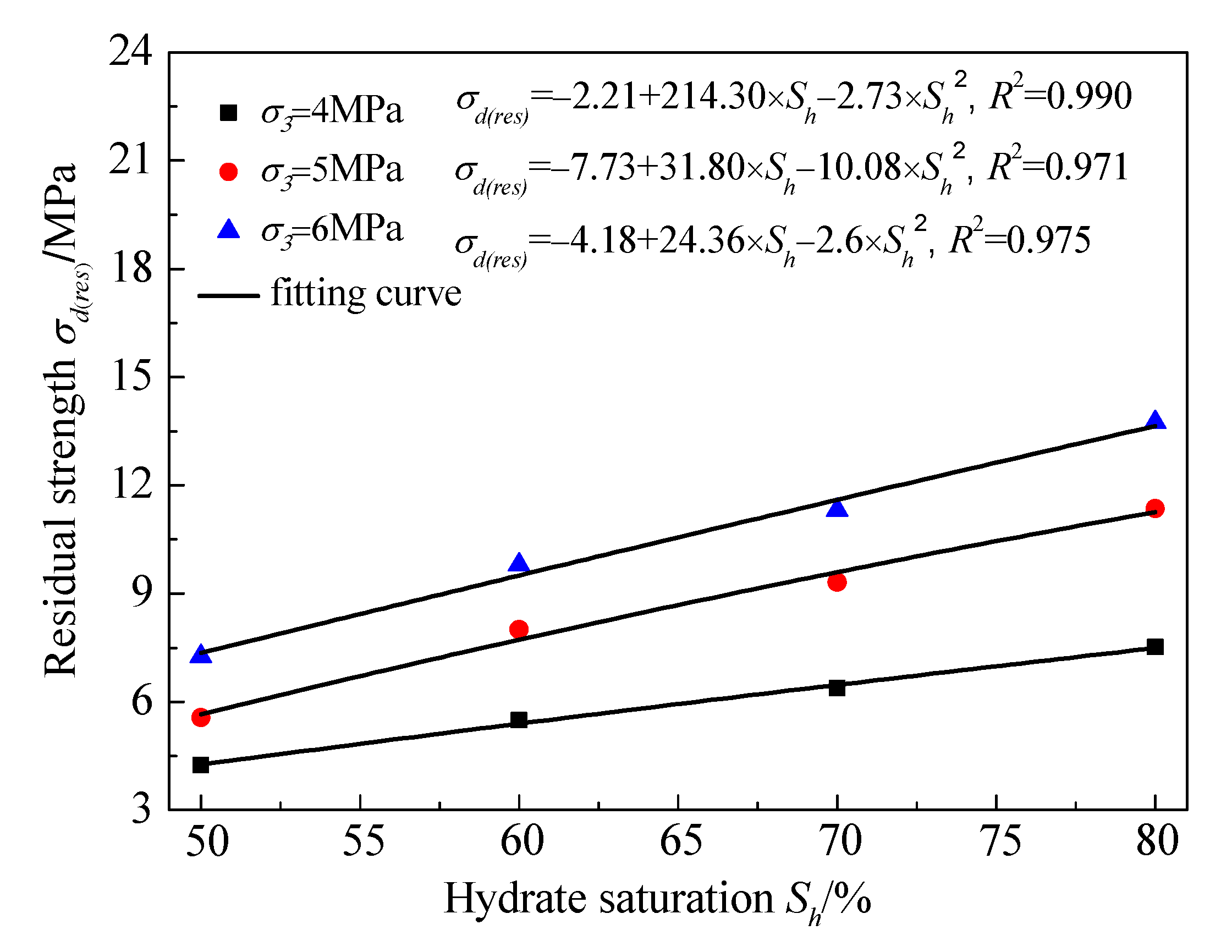
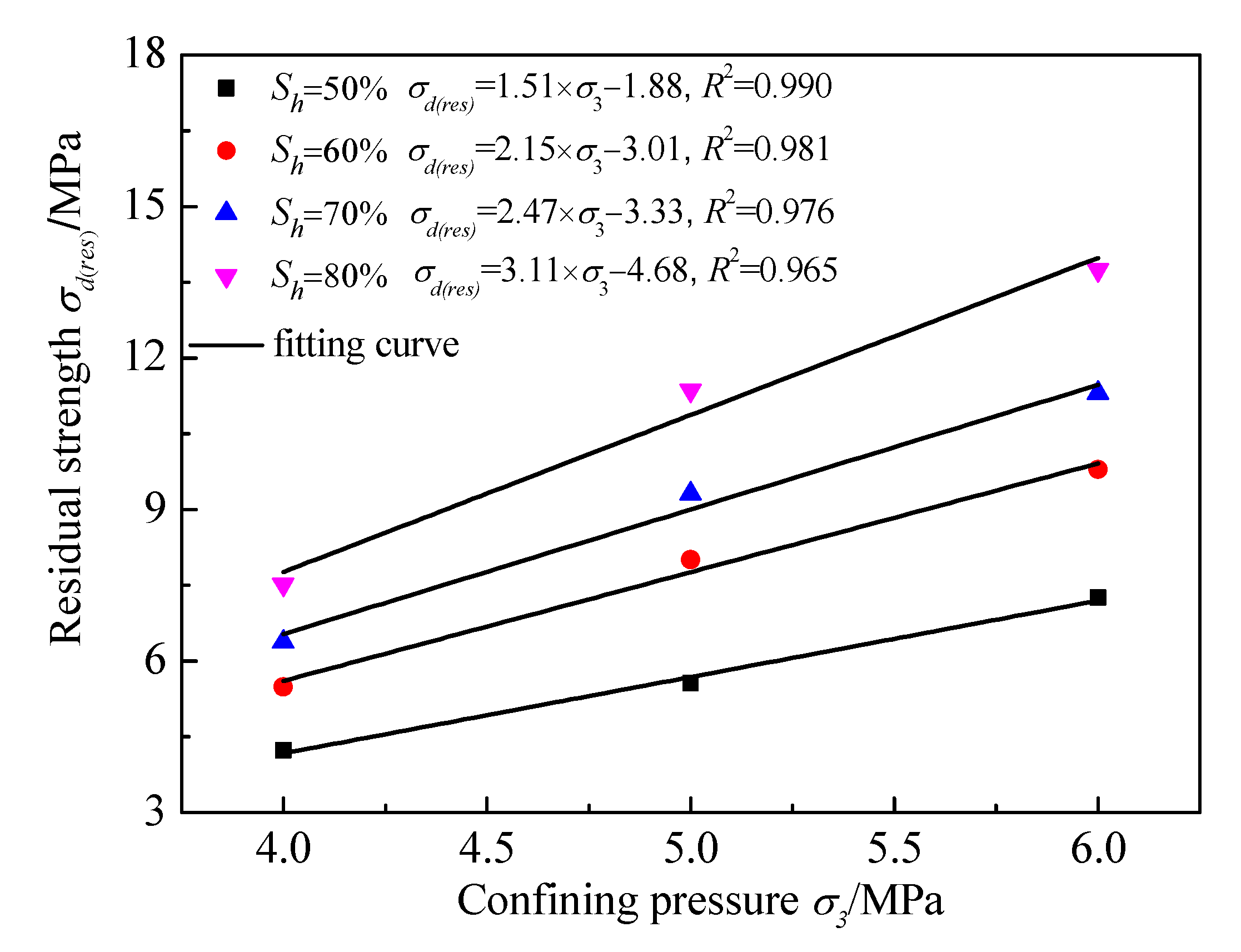
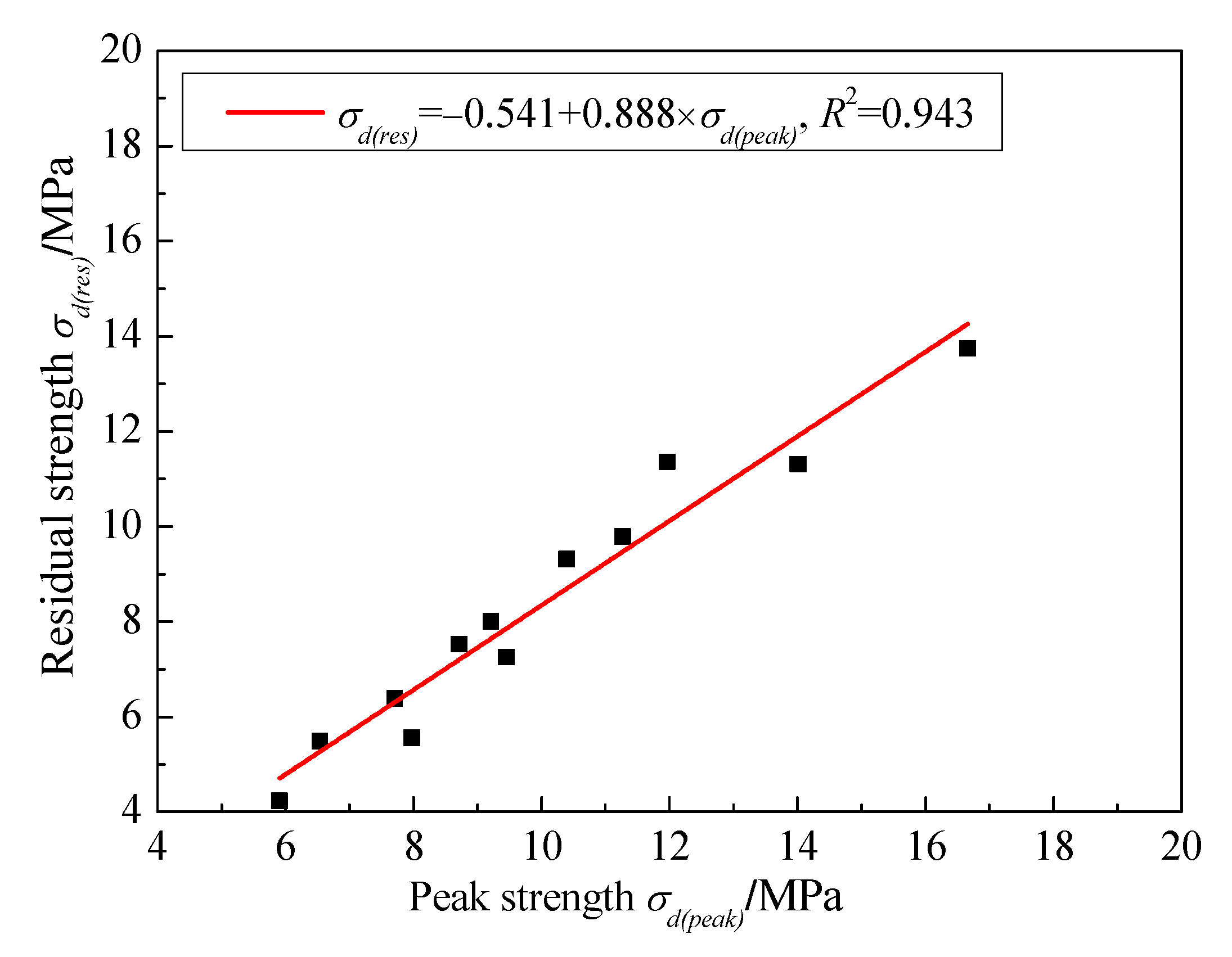
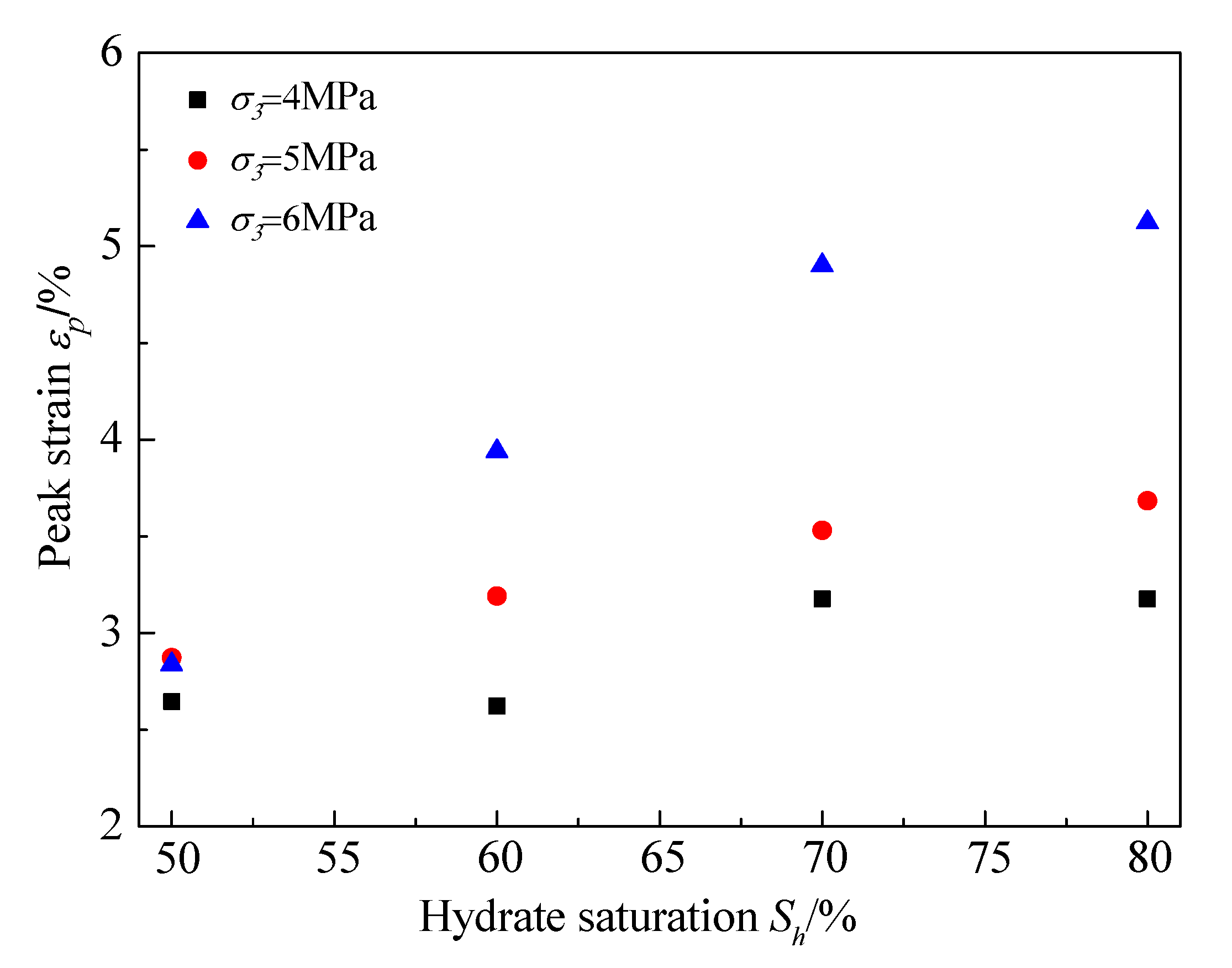
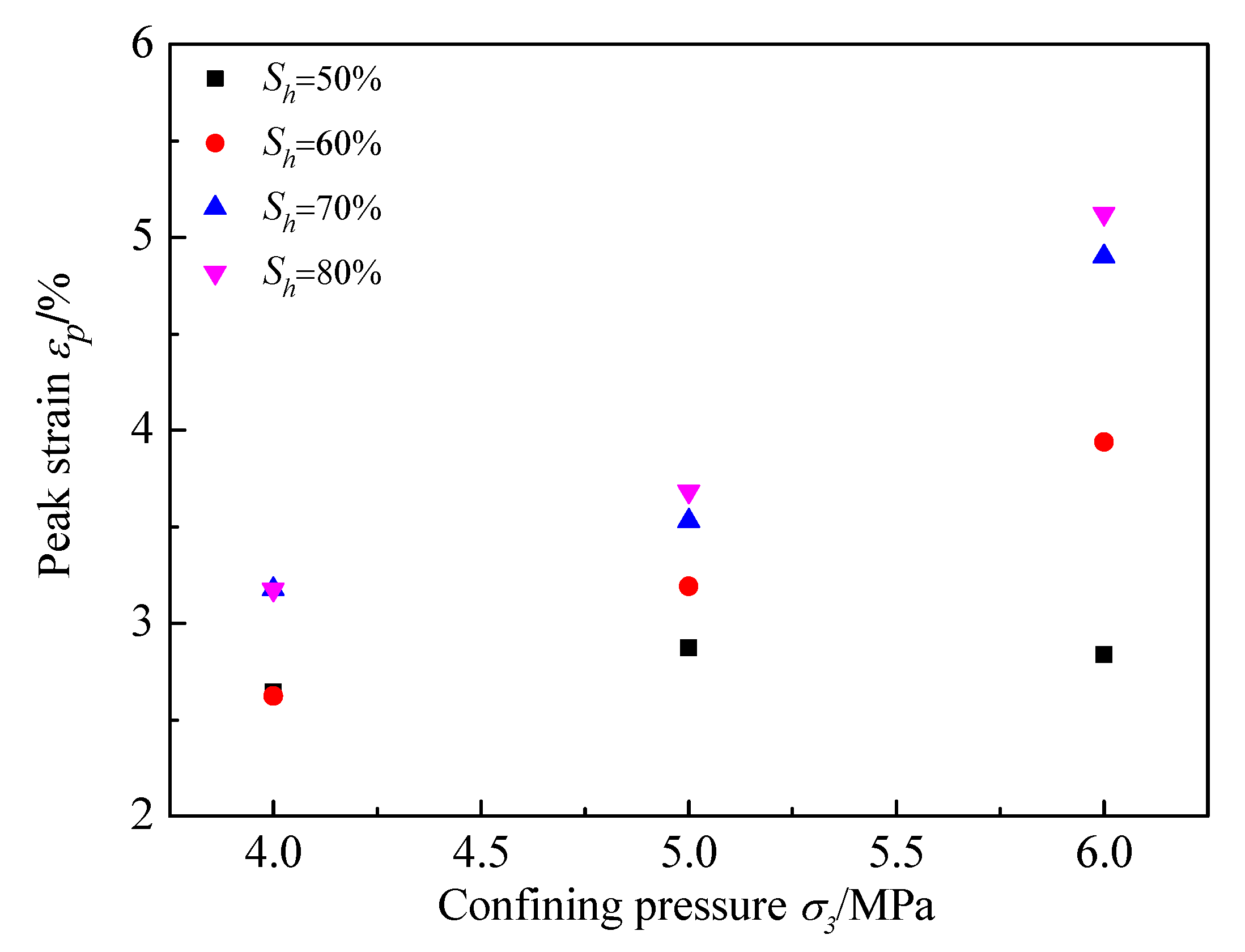
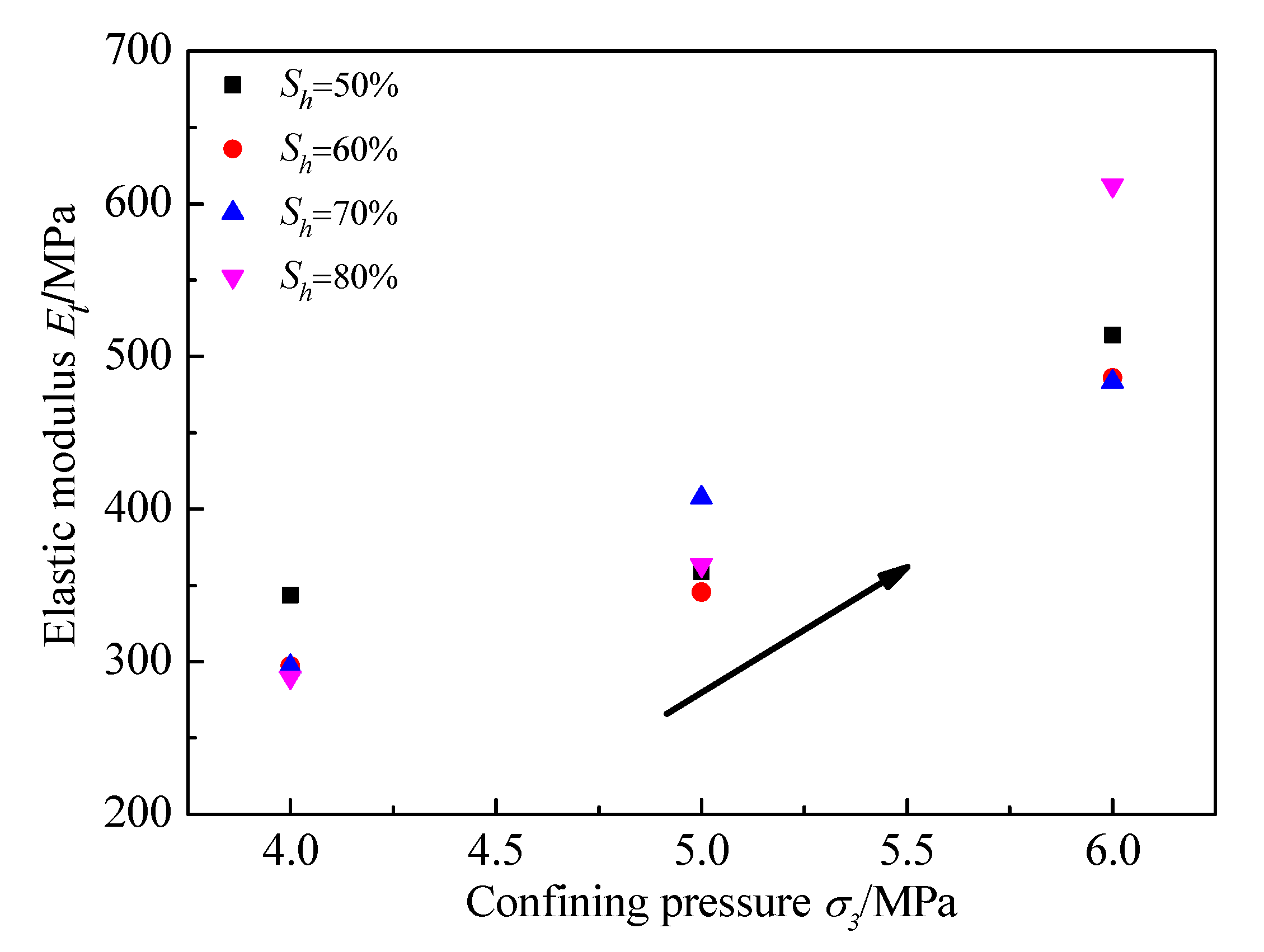
| Test No. | Pore Volume mL/g | Total Pore Volume mL/g | |||
|---|---|---|---|---|---|
| Macro-Pore | Meso-Pore | Micro-Pore | Super-Micro Pore | ||
| X-1 | 0.1239 | 0.022 | 0.0005 | 0 | 0.1464 |
| X-2 | 0.0488 | 0.026 | 0.0325 | 0.005 | 0.1123 |
| X-3 | 0.0853 | 0.0062 | 0.0116 | 0 | 0.1031 |
| X-4 | 0.0839 | 0.0005 | 0.0083 | 0.0053 | 0.098 |
| X-5 | 0.0581 | 0.0546 | 0.0222 | 0.013 | 0.1479 |
| X-6 | 0.1797 | 0.0055 | 0 | 0 | 0.1852 |
| Scheme | Specimen No. | Confining Pressure/MPa | Initial Water Content/g | Temperature/°C | Target Hydrate Saturation/% | Gas Pressure/MPa |
|---|---|---|---|---|---|---|
| I | 50(4) | 4.0 | 19.52 | 0.5 | 50 | 4 |
| 50(5) | 5.0 | 0.5 | 4 | |||
| 50(6) | 6.0 | 0.5 | 4 | |||
| II | 60(4) | 4.0 | 23.42 | 0.5 | 60 | 4 |
| 60(5) | 5.0 | 0.5 | 4 | |||
| 60(6) | 6.0 | 0.5 | 4 | |||
| III | 70(4) | 4.0 | 27.32 | 0.5 | 70 | 4 |
| 70(5) | 5.0 | 0.5 | 4 | |||
| 70(6) | 6.0 | 0.5 | 4 | |||
| IV | 80(4) | 4.0 | 31.23 | 0.5 | 80 | 4 |
| 80(5) | 5.0 | 0.5 | 4 | |||
| 80(6) | 6.0 | 0.5 | 4 |
| Specimen No. | Confining Pressure/MPa | Target Hydrate Saturation/% | Peak Stress /MPa | Residual Deviator Stress /MPa | Maximum Strain /10−2 | Elastic Modulus /MPa |
|---|---|---|---|---|---|---|
| 50(4) | 4.0 | 50 | 5.86 | 4.43 | 2.645 | 343.65 |
| 50(5) | 5.0 | 7.88 | 5.99 | 2.873 | 358.96 | |
| 50(6) | 6.0 | 9.38 | 7.40 | 2.838 | 514.02 | |
| 60(4) | 4.0 | 60 | 6.48 | 5.78 | 2.622 | 297.18 |
| 60(5) | 5.0 | 9.07 | 8.33 | 3.190 | 345.46 | |
| 60(6) | 6.0 | 11.29 | 9.88 | 3.940 | 485.82 | |
| 70(4) | 4.0 | 70 | 7.71 | 6.75 | 3.176 | 297.03 |
| 70(5) | 5.0 | 10.31 | 9.65 | 3.530 | 407.45 | |
| 70(6) | 6.0 | 14.00 | 11.63 | 4.902 | 483.43 | |
| 80(4) | 4.0 | 80 | 8.68 | 7.67 | 3.176 | 298.56 |
| 80(5) | 5.0 | 11.93 | 11.76 | 3.683 | 363.33 | |
| 80(6) | 6.0 | 16.59 | 13.84 | 5.124 | 612.04 |
© 2018 by the authors. Licensee MDPI, Basel, Switzerland. This article is an open access article distributed under the terms and conditions of the Creative Commons Attribution (CC BY) license (http://creativecommons.org/licenses/by/4.0/).
Share and Cite
Gao, X.; Yang, T.; Yao, K.; Zhang, B.; Wu, Q.; Liu, C. Mechanical Performance of Methane Hydrate–Coal Mixture. Energies 2018, 11, 1562. https://doi.org/10.3390/en11061562
Gao X, Yang T, Yao K, Zhang B, Wu Q, Liu C. Mechanical Performance of Methane Hydrate–Coal Mixture. Energies. 2018; 11(6):1562. https://doi.org/10.3390/en11061562
Chicago/Turabian StyleGao, Xia, Tongchuan Yang, Kai Yao, Baoyong Zhang, Qiang Wu, and Chuanhai Liu. 2018. "Mechanical Performance of Methane Hydrate–Coal Mixture" Energies 11, no. 6: 1562. https://doi.org/10.3390/en11061562





